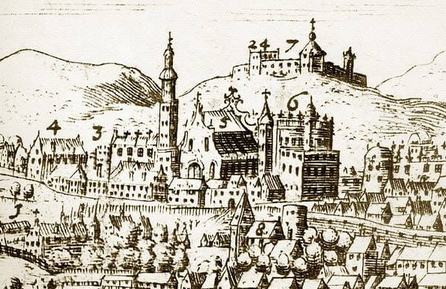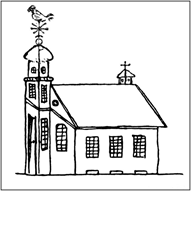The Easter Tumult of 1599 in Vilnius
The Reformation movement reached the Grand Duchy of Lithuania from Western Europe in the 1530s and brought with it many changes – remarkable, but not always positive. The GDL was spared the religious wars that raged across Europe until the mid-17th century, neither did the country experience anything comparable to the St Bartholomew’s Day Massacre of 1572, when Parisian Catholics murdered several thousand Protestants. Despite that, since the early days of the Reformation, competition of rival confessions led to some serious clashes. Contemporary sources refer to them as tumults and turbations.
The 16th century Vilnius saw a total of seven occasions for large-scale unrest, all caused by conflicting religious beliefs. The last of those took place on Easter in 1599 and sent ripples over the entire country.
All eyes on the city centre
It seems that this conflict, just like several prior disturbances, was provoked by the Protestants. They were quite numerous in Vilnius and felt strength in numbers.
Many sources speak of this event, yet establishing the truth has proved difficult. The rival factions provided conflicting reports of the occasion, with the Catholics laying blame on the Protestants and vice versa.
The undisputed fact is that the commotion occurred on Easter, 12 April. We also know that it spread over several locations, including the rotmistrz’s house in the territory of the Lower Castle, the Cathedral, and the Reformed Evangelical Church in what nowadays is Volanas Street.
The fabula of the event is quite simple: the Protestants barricaded the Bishop of Samogitia Merkelis Giedraitis and many other Catholics inside the St Stanislaus Cathedral Church during the Mass. This sparked an unrest involving hundreds of Vilnius residents, who attacked the Reformed Evangelical Church and tried to set it ablaze. During the tumult at least one Protestant was killed, dozens of Vilnans were injured, one student suffered a gunshot wound to his leg.
Different versions of the events
According to the Protestants, Jan Dziewoczka, a Reformed Evangelical, invited several pastors and other guests to his home for lunch in what is now Tiltas Street. After the lunch, some of them went to the St Stanislaus Cathedral Church where the Bishop of Samogitia Merkelis Giedraitis was celebrating the evening mass attended by clergy and students of Vilnius Academy. Upon seeing protestants in a Catholic church, students challenged one evangelical, Nestor Dziewiąty, to discuss matters of faith, but instead beat him and his companions. The fleeing Protestants found a refuge in a house belonging to rotmistrz Kaspary Sleszynski that stood nearby the Lower Castle. Residents of the city started to gather as the gossip about the unrest was spreading. They wanted to break into the territory of the Lower Castle, but the guards closed all the gates. Then enraged men and women started throwing stones and attempted to burn down the house where the Protestants were hiding. The turmoil left several injured. Upon failing to breach the gates to the Lower Castle, the mob attacked the Reformed Evangelical Church killing one of their pastors named Plikhta and injuring several Protestants. Fearing arson, dozens of Protestants stood guard at their church throughout the night.
“
The Catholic version tells that the Protestants who entered the St Stanislaus Cathedral Church were drunk.
The Catholic version tells that the Protestants who entered the St Stanislaus Cathedral Church were drunk. They arrived at the precise moment when the Bishop of Samogitia was administering the sacrament of Confirmation. It was the Protestants who caused the turbulence, while “the vile man”, Nestor Dziewiąty, urged the Catholics out of the church and for this reason was beaten up. Later he went to rotmistrz’s house to continue drinking alongside other Protestants. Roaring drunk, they shut the gates without any reason and by doing so caused further unrest. Moreover, they eventually started beating the people gathered by the cathedral. Protestant hajduks aimed their shots and stones at the cathedral. They kept a number of high-ranking clergymen inside the church for four hours and insulted their envoys. Hearing of such wilfulness, residents of the city, mostly those whose families were locked in the church, stormed the Lower Castle. The situation eased considerably after two noblemen had successfully acted as mediators asking the castle gate to be opened. It took hours before the crowd eventually dissolved, yet some Catholics attacked the Protestant Church. There, the Reformed Evangelicals themselves “killed some Plikhta themselves” and shot a student in the leg.
The news reached the king in Warsaw
Sigismund Vasa, the ruler of the Polish-Lithuanian Commonwealth, ordered an investigation and put Voivode of Vilnius Krzysztof Mikołaj Radziwiłł the Thunderbolt in charge. The king received the news from the Catholics and so was pretty certain that the blame lay on the Protestants.
But Radziwiłł, himself a Reformed Evangelical, came to a very different conclusion. According to him, the Catholics were to blame for the unrest, because they mocked a protestant in their cathedral. The closure of the castle, Radziwiłł maintained, was fully justified because the raging crowd posed a considerable threat.
Protestants involved in the incident were Radziwiłł’s clients, therefore the Voivode of Vilnius punished none of them. Later, however, the Protestants, pressed hard by King Sigismund Vasa, were compelled to sacrifice one of the key culprits, Nestor Dziewiąty. He was sentenced to death on 7 April 1600 for inciting disorder, mocking high clerics, interference with the rites, and other crimes. However, it remains unclear if he was executed, because his friends, the local Protestants, were influential enough to spare him from death.











